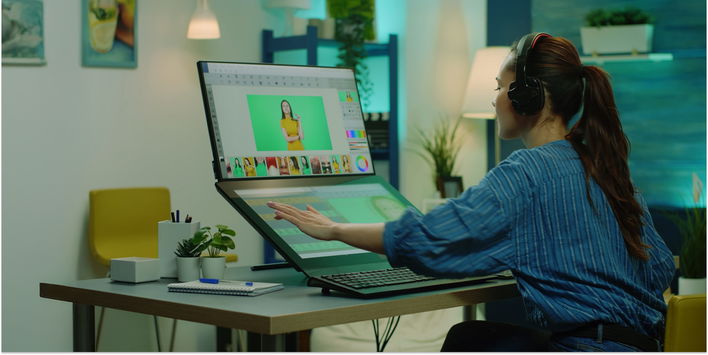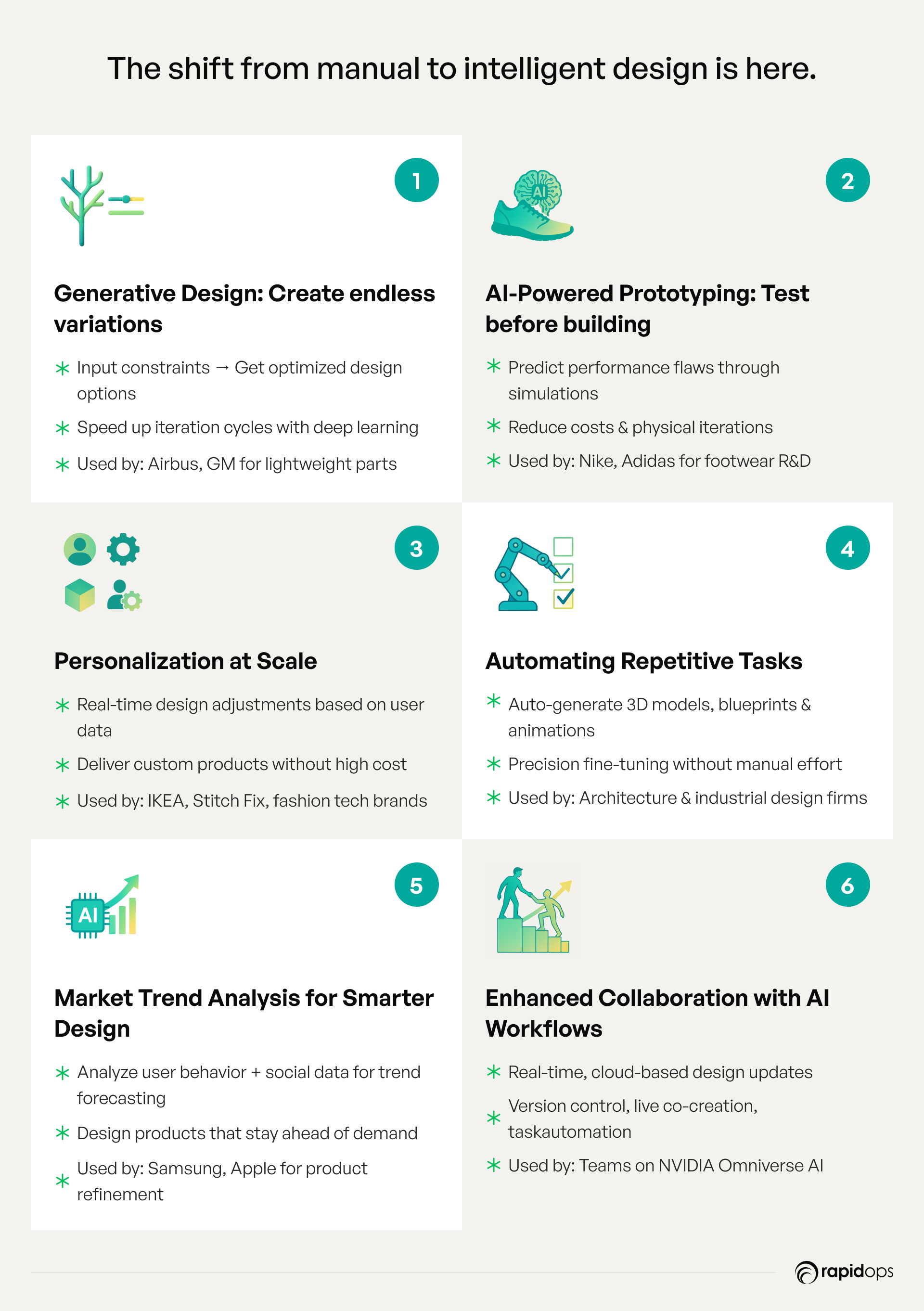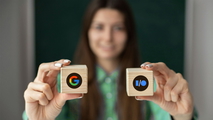AI for product design is not limited to being a buzzword anymore—it's a transformative force reshaping the way companies innovate and create.
Imagine cutting down design timelines by half while simultaneously boosting creativity and precision. This isn’t a futuristic fantasy; it’s the reality for businesses leveraging artificial intelligence in product development.
Consider this: Companies like Rapidops Inc. are already integrating AI-driven design innovation to streamline their product development processes, from ideation to prototype.
AI-powered tools are now capable of generating multiple design iterations in minutes, enabling businesses to test and refine ideas with unprecedented speed and efficiency.
This technology is especially valuable for business owners looking to stay ahead of the curve in a competitive market.
In this article, we’ll explore:
- How AI is transforming product design: Delving into the mechanisms behind AI’s role in product innovation.
- Working mechanisms in detail: A deep dive into how AI tools like generative design and machine learning are practically applied in product design workflows.
- Real-world success stories: Insightful examples from industries that have embraced AI to enhance their product development process.
Whether you’re a business owner seeking to innovate or an industry leader eager to optimize your design workflow, this guide will provide you with the actionable insights and knowledge you need to harness the power of AI.
The working mechanism behind AI in product design
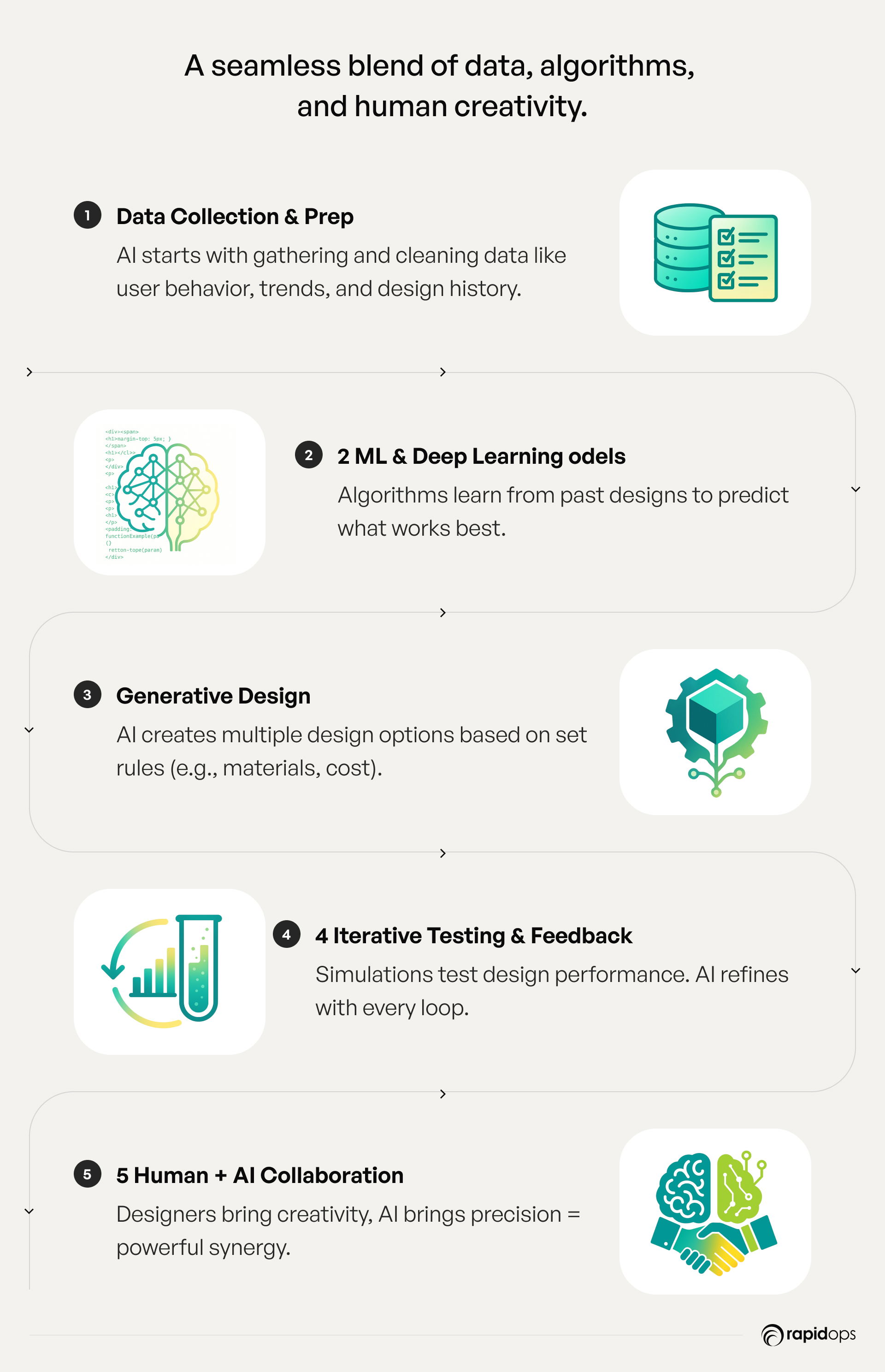
At its core, the integration of AI into product design is about combining data-driven insights with creative processes. Here’s a detailed look at how this working mechanism unfolds:
1. Data collection and preparation
AI begins with vast amounts of data—ranging from customer preferences to historical design outcomes.
This data is cleaned, categorized, and structured to form the basis for machine learning models. In many cases, businesses invest in proprietary datasets or tap into open-source data to ensure their models have the depth required for effective design analysis.
2. Machine learning and deep learning models
Once the data is prepared, machine learning (ML) and deep learning algorithms come into play.
These models learn patterns from past designs and user interactions, enabling them to predict trends and suggest design elements that resonate with target audiences.
For example, neural networks can analyze countless design iterations to identify subtle features that improve usability or aesthetic appeal.
3. Generative design process
One of the most transformative applications is generative design.
Here, AI algorithms generate multiple design alternatives based on a set of predefined constraints—such as material limits, manufacturing processes, and performance requirements. Designers then review these suggestions, refining and iterating further.
This not only speeds up the creative process but also uncovers innovative solutions that might not be immediately apparent through traditional design methods.
4. Iterative testing and feedback loops
AI systems are built to continuously improve.
After an initial design is generated, simulations and virtual testing environments evaluate its performance against real-world criteria. Feedback loops allow the AI to learn from each iteration—whether the design excels in durability, user engagement, or cost-efficiency.
This iterative process ensures that the final product is both innovative and functional.
5. Integration with human expertise
Importantly, AI does not work in isolation. It complements human creativity and strategic thinking. Designers use AI-generated insights as a springboard, merging technical feasibility with creative vision.
This hybrid approach ensures that the final product benefits from both algorithmic precision and human nuance, leading to more robust and market-ready designs.
By understanding this detailed working mechanism, business owners can appreciate how AI transforms product design into a highly efficient, iterative, and innovative process—ultimately enabling companies to deliver products that are both groundbreaking and finely tuned to market needs.
The evolution of AI in product design
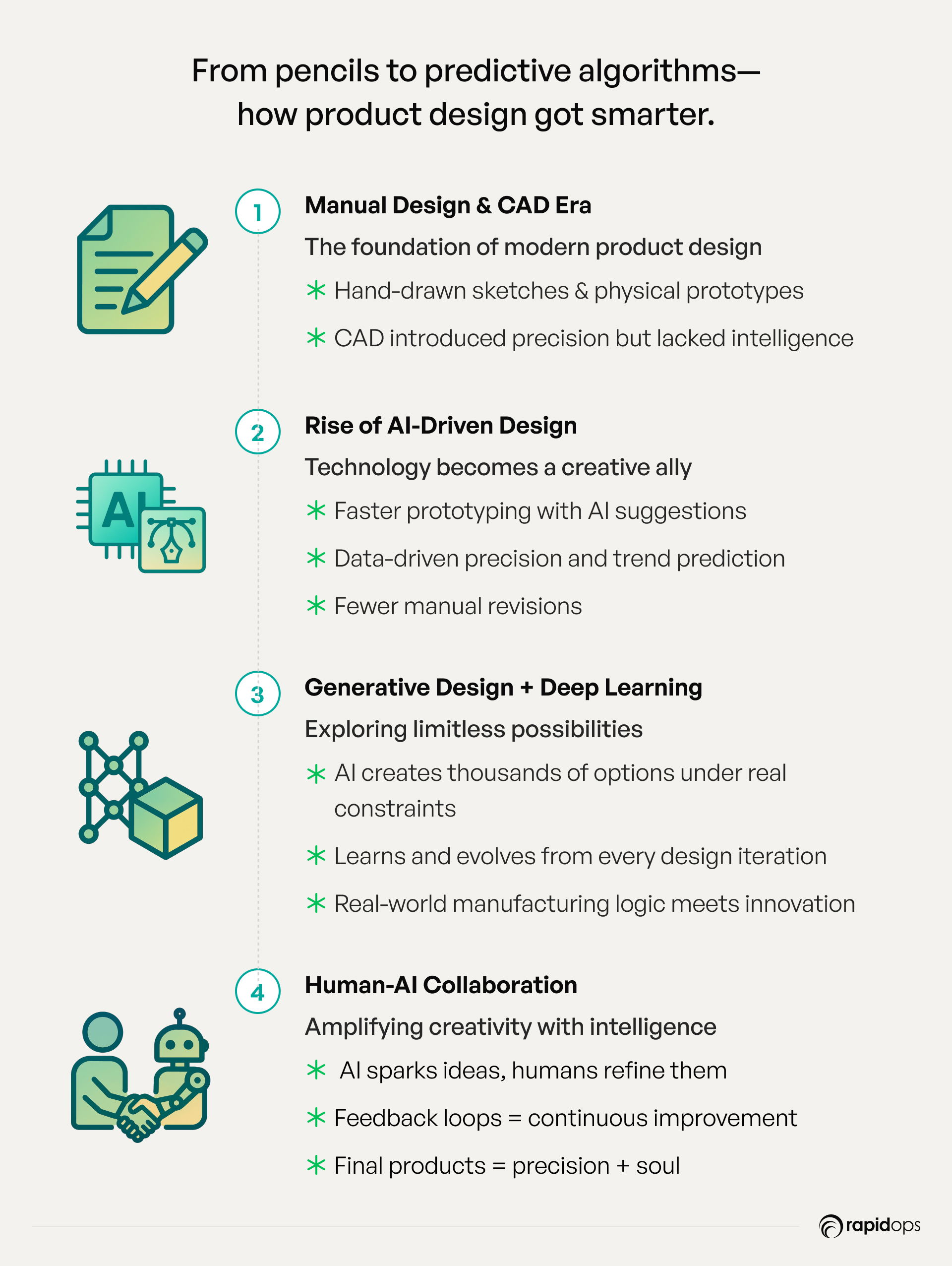
Imagine if you could go from a rough sketch to a fully refined product model in a fraction of the time it used to take.
That’s the promise AI brings to the world of product design—a journey that has evolved from hand-drawn blueprints to intelligent systems that partner with human creativity.
1. Early design processes and the advent of CAD
Remember the days when product design meant countless hours with a pencil and paper?
Early on, designers relied on manual sketches and physical prototypes, which often meant long iterations and slower progress.
The introduction of computer-aided design (CAD) changed the game by allowing precise digital models. Although CAD was a significant leap forward, it served mainly as a digital tool rather than a creative assistant.
2. Emergence of AI-driven design innovation
Fast forward to today, and AI has become a trusted partner in product design. With AI for product design, businesses are no longer limited by the slow pace of manual revisions. Instead, AI tools can:
- Enhance design precision: They sift through massive datasets to spot trends and predict outcomes that can refine design decisions.
- Accelerate prototyping: By generating multiple iterations quickly, AI cuts down the time from concept to prototype dramatically.
- Support data-driven decisions: Leveraging historical design data, AI offers insights that help fine-tune new products with precision.
3. Integration of generative design and deep learning
One of the most exciting chapters in this evolution is the rise of generative design powered by deep learning. Picture an AI that can explore thousands of design possibilities based on real-world constraints like material properties and manufacturing limits. This innovative process allows companies to:
- Discover unique design alternatives: Generative design algorithms propose multiple, viable options that a human might not have considered.
- Learn from every iteration: Deep learning models continuously improve by analyzing feedback from previous designs, blending creativity with data accuracy.
4. Bridging human creativity and technological advancement
At its best, AI doesn’t replace human ingenuity—it amplifies it. Today, designers are finding that the most successful products come from a seamless collaboration between human expertise and AI insights. This hybrid approach creates:
- Collaborative workflows: AI-generated ideas spark creative discussions, leading to more refined and market-ready products.
- Continuous improvement: Ongoing feedback loops between AI tools and designers ensure that each product iteration is better than the last.
The evolution of product design shows us that while technology has dramatically transformed the process, the core of innovation still relies on human creativity. For business leaders, this means embracing AI is not about replacing people but about empowering them to push the boundaries of what’s possible.
Key ways AI is transforming product design
AI is no longer just an experimental tool in product design—it’s a game-changer. From concept development to final prototyping, AI is streamlining workflows, unlocking creativity, and making the impossible possible. The question isn’t whether AI can enhance product design, but rather how businesses can integrate it effectively to stay ahead of the competition.
Here are some of the most powerful ways AI is transforming product design today:
1. Generative design: Exploring endless possibilities
Imagine feeding an AI system a set of design requirements—weight limits, material choices, structural constraints—and getting hundreds of optimized design variations in minutes. That’s exactly what generative design does.
- AI algorithms use deep learning and predefined parameters to create multiple design iterations automatically.
- Instead of starting from scratch, designers can evaluate AI-generated options and refine them, leading to faster and more efficient design cycles.
- Example: Aerospace and automotive companies, like Airbus and General Motors, use generative AI to develop lightweight, high-performance components that would be impossible to design manually.
2. AI-powered prototyping: Reducing time and cost
Traditional prototyping can be expensive and time-consuming, requiring multiple iterations and physical tests. AI speeds up this process by simulating performance, identifying flaws, and optimizing designs before a physical model is even created.
- Machine learning models analyze previous designs to predict weaknesses and suggest improvements.
- AI-powered simulation tools allow businesses to test virtual prototypes under real-world conditions, saving both money and time.
- Example: Sportswear brands like Nike and Adidas leverage AI-driven testing environments to refine shoe design, ensuring maximum comfort and durability without producing unnecessary prototypes.
3. AI-driven personalization and customization
One-size-fits-all is no longer enough—modern consumers expect products tailored to their needs. AI is helping businesses deliver hyper-personalized designs based on user data, behavior, and preferences.
- AI analyzes consumer insights to generate personalized product recommendations in real time.
- Businesses can design unique, customized products at scale without increasing costs.
- Example: Fashion and interior design brands like IKEA and Stitch Fix use AI to create personalized product designs that match individual customer preferences.
4. Automating repetitive design tasks
AI doesn’t just help with innovation—it also eliminates the mundane and repetitive aspects of product design. This allows designers to focus on creativity while AI handles the heavy lifting.
- AI tools can automatically generate blueprints, 3D models, and animations.
- Designers no longer need to manually adjust minute details—AI fine-tunes elements with precision and consistency.
- Example: Architecture firms and industrial design teams are using AI-driven CAD tools to speed up drafting and modeling tasks.
5. AI-powered market trend analysis for better design decisions
AI isn't just about creating products—it’s also about ensuring they meet market demands. By analyzing vast amounts of consumer data, AI helps businesses anticipate trends, adapt designs, and make smarter product decisions.
- AI tools process data from social media, purchase behaviors, and industry reports to predict emerging trends.
- Businesses can adjust product designs proactively, reducing the risk of launching irrelevant or outdated products.
- Example: Consumer electronics brands like Samsung and Apple use AI-driven insights to refine their product lines based on user engagement and purchasing patterns.
6. Enhancing collaboration with AI-assisted workflows
In an increasingly digital world, AI is breaking down barriers between designers, engineers, and decision-makers by enabling seamless collaboration.
- Cloud-based AI tools allow teams across different locations to work on a single design in real time.
- AI assists in project management, design revisions, and version control, ensuring smooth workflow integration.
- Example: Companies using NVIDIA Omniverse AI collaborate remotely on complex product designs with real-time AI enhancements.
AI is no longer just a supporting tool in product design—it’s an essential driver of efficiency, innovation, and creativity.
Businesses that embrace AI-powered design processes are not just keeping up with the competition; they’re redefining what’s possible in their industries.
AI tools and technologies driving product design
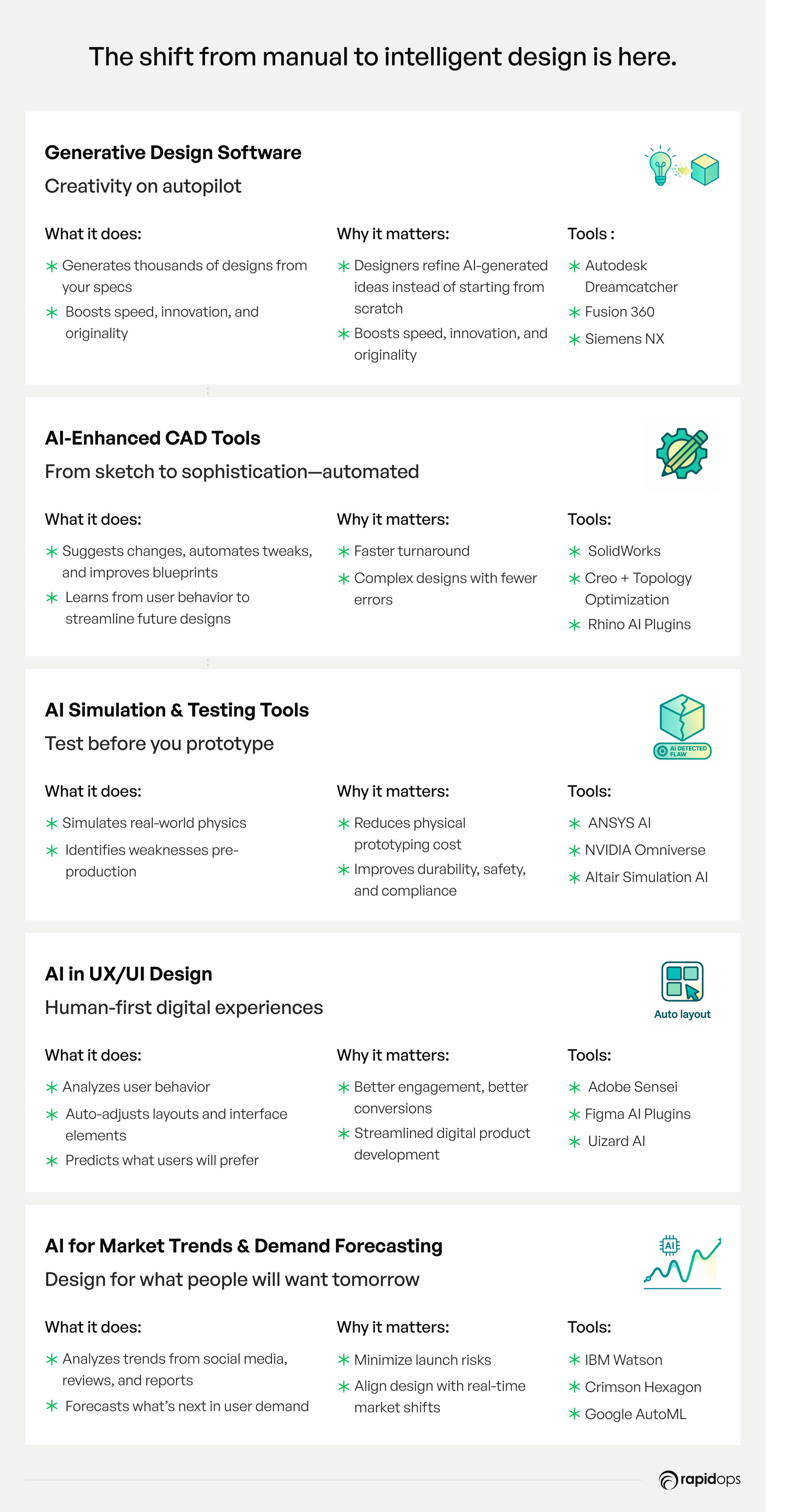
AI is already embedded in the daily workflows of businesses that want to design better, faster, and more efficiently. But what’s powering this transformation?
Let’s break down the AI tools and technologies that are reshaping product design today.
1. Generative design software: AI-powered creativity at scale
If you’ve ever struggled with brainstorming product ideas or optimizing designs, generative AI tools can do the heavy lifting. These tools take a set of inputs—like material, cost, weight, and strength requirements—and generate thousands of design variations in minutes.
- How it works: AI-powered algorithms explore all possible design solutions, suggesting unconventional yet highly optimized designs.
- Why it matters: Instead of starting from scratch, designers can evaluate AI-generated options and refine them, saving time and unlocking innovative possibilities.
- Popular tools:
- Autodesk Dreamcatcher – A leading AI-powered tool that creates design variations based on user-defined constraints.
- Fusion 360 with generative design – Used in manufacturing to optimize product weight, material usage, and structural integrity.
- Siemens NX – Helps engineers enhance product efficiency and reduce waste through AI-driven design.
2. AI-driven CAD tools: Smarter, faster, and more precise design
Traditional CAD (computer-aided design) software is getting a major upgrade with AI capabilities. These next-generation AI-assisted CAD tools help designers speed up the process and reduce errors.
- How it works: AI-powered CAD tools suggest design modifications, automate repetitive tasks, and refine blueprints.
- Why it matters: Businesses can develop complex product designs without needing to manually tweak every detail, increasing efficiency.
- Popular tools:
- SolidWorks AI-powered features – Automates design modifications based on past user behavior.
- Creo (PTC) with AI-driven topology optimization – Refines product structure for performance and durability.
- Rhino AI Plugins – Helps in architecture, fashion, and product modeling with AI-assisted 3D design.
3. AI-powered simulation and testing tools
Before a product ever reaches the prototype stage, AI can simulate real-world performance to predict failures, stress points, and durability.
- How it works: AI-driven simulation tools analyze how a product will react to pressure, temperature, and external forces, reducing the need for physical prototypes.
- Why it matters: Businesses can save millions on testing costs and create safer, more durable products before manufacturing.
- Popular tools:
- ANSYS AI Simulation – Predicts material performance under extreme conditions.
- NVIDIA Omniverse AI – Simulates real-world interactions for product testing and collaboration.
- Altair AI-powered simulation – Assists in aerospace, automotive, and industrial product testing.
4. AI in UX/UI design: Human-centered digital experiences
AI isn’t just transforming physical product design—it’s also enhancing digital interfaces and user experiences (UX/UI).
- How it works: AI tools analyze user behavior, suggest design improvements, and automate layout adjustments for websites, apps, and digital products.
- Why it matters: Businesses can improve usability, engagement, and conversions by ensuring designs align with user preferences.
- Popular tools:
- Adobe Sensei AI – Provides automated UI enhancements and predictive design insights.
- Figma AI Plugins – Uses AI to optimize UI layouts, typography, and responsiveness.
- Uizard AI – Turns sketches into fully functional digital prototypes in minutes.
5. AI for market research and trend forecasting
Designing a great product is one thing—but ensuring it meets market demand is just as critical. AI-powered trend analysis tools help businesses predict what customers want before they even know it themselves.
- How it works: AI scans social media, online reviews, and industry reports to identify emerging consumer preferences and design trends.
- Why it matters: Businesses can align product development with real-time market demand, reducing the risk of failed launches.
- Popular tools:
- IBM Watson AI for market research – Extracts insights from massive datasets to inform product development.
- Crimson Hexagon AI – Monitors customer sentiment and trend shifts across industries.
- Google AutoML for demand forecasting – Predicts future trends using historical consumer behavior data.
The businesses thriving in today’s fast-paced market aren’t just using AI for product design—they’re embedding AI into every stage of their workflow. From generative design to AI-powered testing, the right tools can mean the difference between creating a breakthrough product and falling behind the competition.
Challenges and considerations in AI-based product design
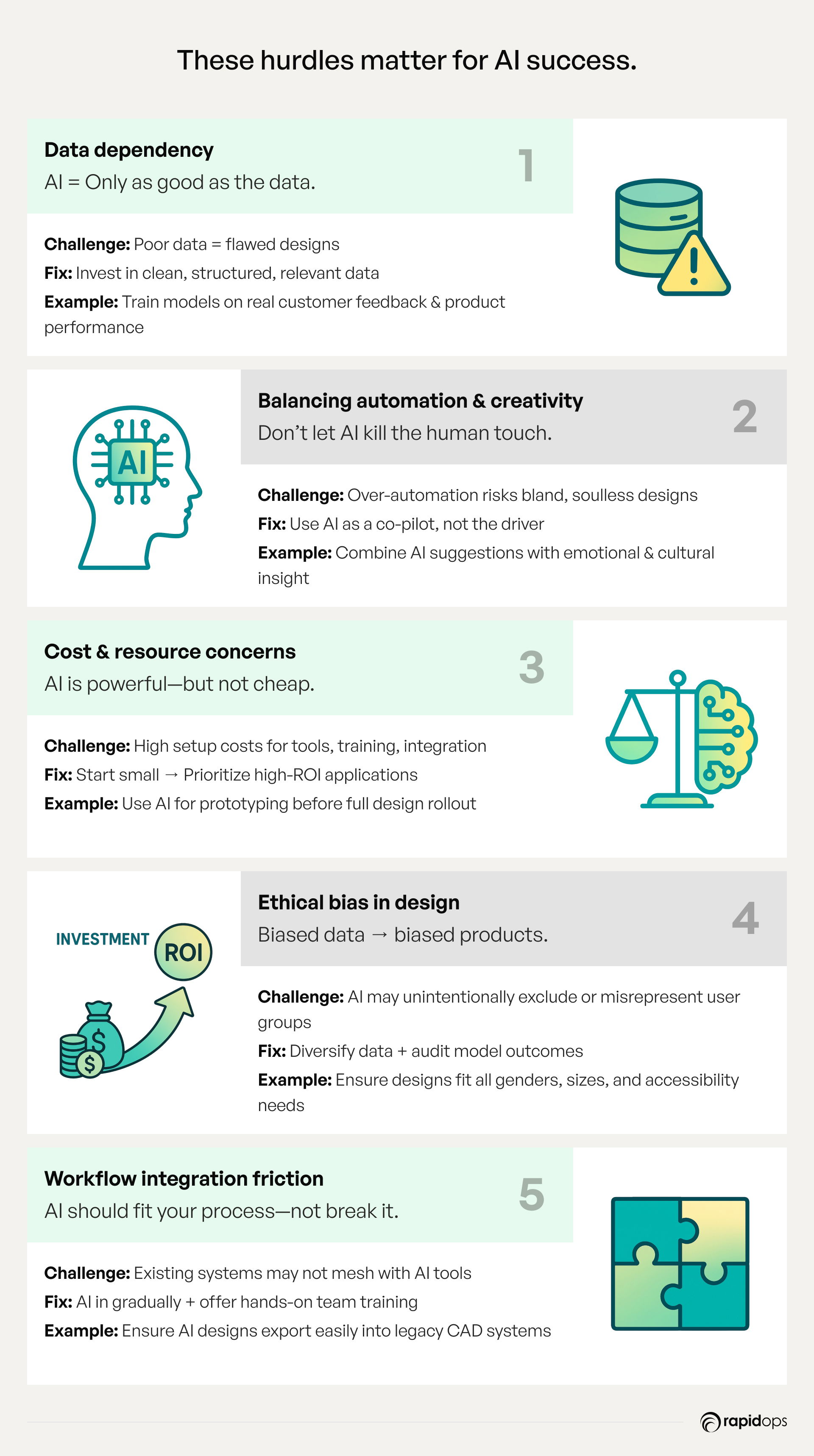
AI in product design offers undeniable advantages—faster iterations, cost savings, and optimized designs. But integrating AI into a business’s workflow isn’t always straightforward. Companies must navigate certain challenges and considerations to maximize AI’s benefits while mitigating risks.
1. Data dependency: AI is only as good as the data it learns from
AI models don’t create magic out of thin air—they rely on high-quality, diverse, and structured data to function effectively. If a business lacks enough relevant data, the AI’s design suggestions can be inaccurate or impractical.
- Challenge: Poor-quality data leads to flawed outputs, which can result in unrealistic or non-viable product designs.
- Consideration: Companies must invest in data collection, cleaning, and structuring to ensure AI is working with reliable inputs.
Example: A consumer electronics company using AI for product design must train its model on actual user feedback, performance metrics, and historical design successes to generate meaningful recommendations.
2. Balancing AI automation with human creativity
AI is great at optimizing designs based on logic and constraints, but it lacks human intuition and emotional intelligence—two critical factors in successful product design.
- Challenge: Businesses risk over-relying on AI and losing the unique, creative touch that makes a product stand out.
- Consideration: AI should act as a co-pilot, not a replacement for human designers. The best results come from AI-human collaboration.
Example: A fashion brand using AI-generated clothing designs must ensure they align with customer sentiment and cultural aesthetics—something AI alone might not fully grasp.
3. High implementation costs and resource allocation
AI tools and infrastructure can be costly, especially for small and mid-sized businesses (SMBs). The cost isn’t just about buying AI-powered software—it also includes training employees, integrating AI into existing workflows, and maintaining AI models.
- Challenge: Initial investments in AI can be significant, making it hard for SMBs to justify the cost.
- Consideration: Businesses should start small, prioritize high-impact AI applications, and scale gradually to maximize ROI.
Example: A manufacturing company may begin by integrating AI into prototyping and simulation before expanding AI into full-scale generative design.
4. Ethical concerns and AI bias
AI models learn from historical data—but if that data contains biases, AI can reinforce and amplify those biases in product designs. This is especially concerning in industries like consumer tech, healthcare, and fashion, where diversity and inclusivity are key.
- Challenge: AI-generated designs may unintentionally exclude certain demographics or reinforce outdated design stereotypes.
- Consideration: Companies must audit AI decisions regularly and ensure diverse data inputs to create fair and inclusive designs.
Example: A wearable tech company using AI to design smartwatches must ensure the fit, interface, and accessibility features are optimized for all users—not just a narrow demographic.
5. Integration with existing design workflows
Businesses that already have well-established CAD, prototyping, and R&D processes may struggle with integrating AI smoothly. AI tools need to work alongside existing software, teams, and workflows without disrupting productivity.
- Challenge: AI adoption requires workflow adjustments, and employees may resist change.
- Consideration: Businesses should gradually introduce AI, provide training, and ensure AI tools integrate seamlessly with existing systems.
Example: An automotive design team using Autodesk Fusion 360 with AI must ensure that AI-generated models are compatible with traditional CAD files for further refinement.
Despite these challenges, AI is proving to be a “must-have” rather than a “nice-to-have" in product design.
Businesses that proactively address these considerations—by investing in data quality, ethical AI use, and employee training—will be better positioned to reap the full benefits of AI-powered innovation.
The future of AI in product design and how businesses can prepare
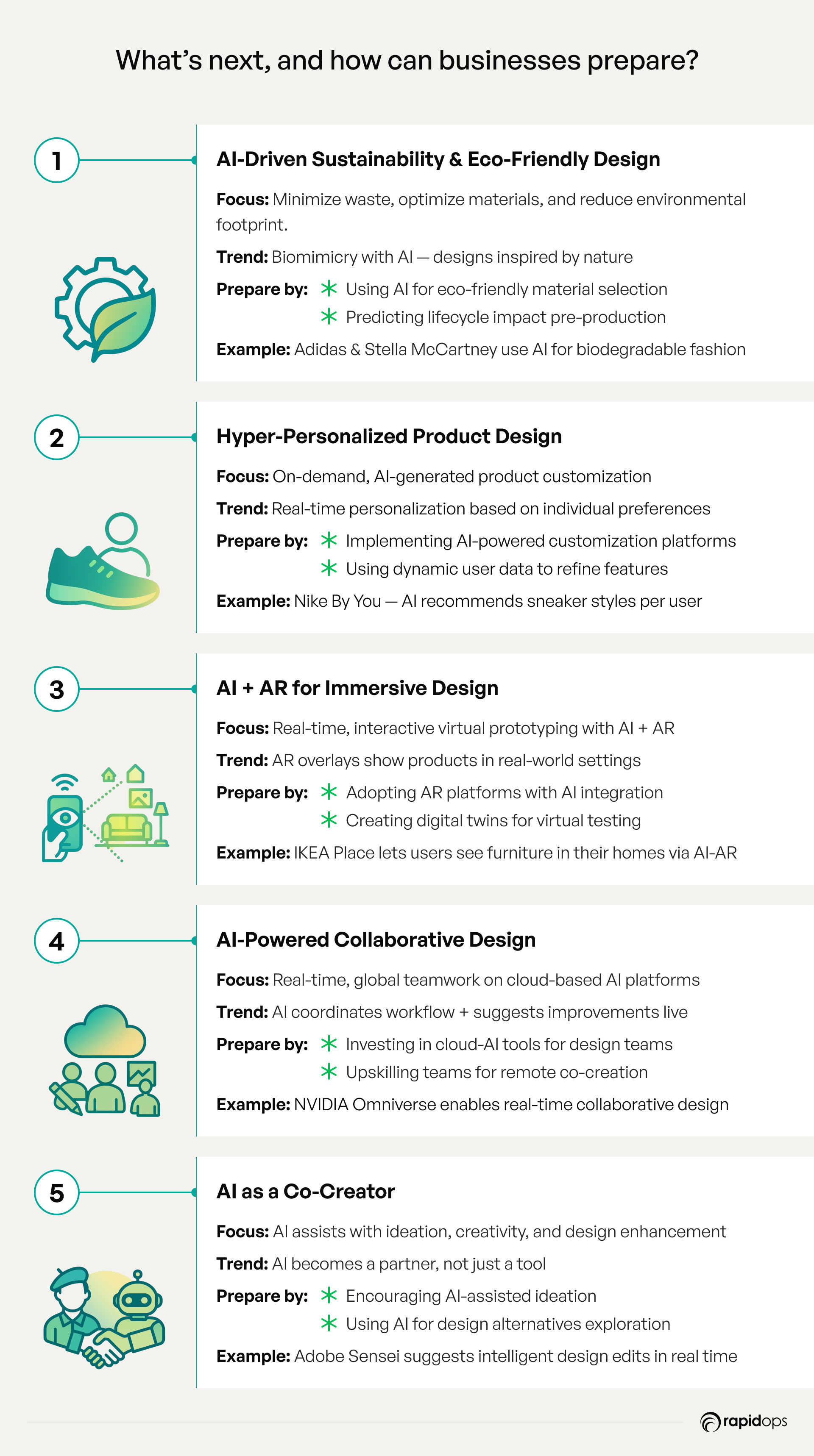
AI in product design is still evolving, and what we see today is just the beginning.
As AI models become more sophisticated and accessible, businesses that embrace these advancements will stay ahead of the curve—while those that hesitate risk falling behind.
So, what’s next for AI in product design, and how can businesses prepare for the future?
1. AI-driven sustainability and eco-friendly design
Sustainability is no longer an afterthought—it’s a business necessity. AI is helping companies design products with minimal environmental impact by optimizing materials, reducing waste, and creating energy-efficient designs.
- Emerging trend: AI-driven biomimicry—where AI mimics natural processes to design more sustainable and efficient products.
- How businesses can prepare:
- Invest in AI tools that optimize material selection and energy consumption.
- Use AI-powered lifecycle analysis to predict a product’s environmental footprint before production.
Example: Companies like Adidas and Stella McCartney are already using AI to develop sustainable, biodegradable fashion materials.
2. Hyper-personalized product design with AI
Consumers are demanding more personalized products, and AI is making mass customization possible. By analyzing individual user preferences and behaviors, AI can generate customized designs in real-time.
- Emerging trend: AI-powered on-demand product design, where products are manufactured based on real-time consumer needs rather than mass production.
- How businesses can prepare:
- Adopt AI-driven customization platforms to offer personalized products.
- Leverage AI for dynamic user feedback to refine product features instantly.
Example: Nike By You allows customers to personalize their sneakers using AI-driven recommendations based on past purchases and style preferences.
3. AI and augmented reality (AR) for immersive design experiences
The future of product design isn’t just AI-powered—it’s also interactive and immersive. AI combined with AR will allow businesses to create real-time virtual prototypes that customers and designers can experience before manufacturing begins.
- Emerging trend: AI-powered AR tools will let businesses visualize and modify designs in real-world settings before production.
- How businesses can prepare:
- Explore AI-integrated AR platforms for virtual product testing and prototyping.
- Use AI-generated digital twins to simulate product performance in various environments.
Example: IKEA Place uses AI and AR to let customers see how furniture fits in their homes before purchasing.
4. AI-powered collaborative design for remote teams
With remote work becoming the norm, AI will play a crucial role in streamlining global design collaboration. AI-driven cloud platforms will allow teams from different locations to work on a single design in real-time, reducing miscommunication and accelerating innovation.
- Emerging trend: AI will automate workflow coordination, suggest design improvements, and provide real-time design feedback across distributed teams.
- How businesses can prepare:
- Invest in AI-powered cloud design platforms that enhance team collaboration.
- Train teams to leverage AI for seamless cross-functional design integration.
Example: Companies using NVIDIA Omniverse can collaborate on AI-enhanced designs in real time, regardless of location.
5. AI as a co-creator: Enhancing human creativity
As AI becomes more advanced, it won’t just assist designers—it will actively co-create alongside them, offering real-time design suggestions, detecting inefficiencies, and enhancing human creativity.
- Emerging trend: AI will shift from being a tool for automation to a creative partner that enhances rather than replaces human input.
- How businesses can prepare:
- Foster a culture of AI-assisted creativity, encouraging designers to leverage AI as a collaborator.
- Implement AI in early-stage ideation to explore unconventional yet viable design alternatives.
Example: Adobe Sensei AI is already assisting designers by making intelligent suggestions for creative projects, from branding to product packaging.
AI is reshaping the design landscape, and businesses that embrace AI innovation today will lead tomorrow’s markets. Here’s how to get ahead:
- Invest in AI training and education – Equip teams with the skills to use AI effectively.
- Adopt AI incrementally – Start with AI-driven design enhancements before scaling to full AI automation.
- Leverage AI-powered customer insights – Align product design with real consumer needs and market trends.
- Prioritize ethical AI use – Ensure AI-driven designs promote inclusivity and sustainability.
The businesses that thrive in the AI-powered future will not be the ones that resist change, but the ones that embrace it strategically.
Conclusion
AI is no longer just a tool for automation—it is a strategic advantage in product design, enabling businesses to accelerate innovation, optimize workflows, and create user-centric products.
The shift is already happening, and companies that integrate AI into their design process today will set themselves apart in the competitive landscape of tomorrow.
At Rapidops, we go beyond just implementing AI. Our approach combines cutting-edge AI technologies with the expertise of our in-house UI/UX masters to bring your business ideas to life.
While AI helps analyze data, predict trends, and optimize designs, our human-centric design philosophy ensures that every product remains intuitive, functional, and aligned with customer expectations.
How Rapidops Inc. leverages AI for product design -
- AI-powered ideation: We use AI-driven insights to generate innovative product concepts tailored to your business goals.
- Human-centered UI/UX design: Our in-house UI/UX experts refine AI-generated design suggestions, ensuring that products are not only efficient but also engaging and user-friendly.
- Data-driven design optimization: AI helps us analyze user behavior and market trends, allowing us to continuously refine and enhance product experiences.
- AI-assisted prototyping and testing: We use machine learning models to simulate real-world product interactions, reducing development risks and optimizing performance before launch.
Our AI-first approach ensures that businesses do not just adopt AI for the sake of innovation but leverage it to build products that solve real problems, enhance customer experiences, and drive revenue growth.
If you are exploring AI-driven product design, now is the time to take action. Get on a consultation call with our digital product and AI specialists to discuss how AI can be seamlessly integrated into your product development strategy and help turn your vision into reality.
Let’s shape the future of your product design together. Connect with us today!

Saptarshi Das
Content Editor
9+ years of expertise in content marketing, SEO, and SERP research. Creates informative, engaging content to achieve marketing goals. Empathetic approach and deep understanding of target audience needs. Expert in SEO optimization for maximum visibility. Your ideal content marketing strategist.
What’s Inside
- The working mechanism behind AI in product design
- The evolution of AI in product design
- Key ways AI is transforming product design
- AI tools and technologies driving product design
- Challenges and considerations in AI-based product design
- The future of AI in product design and how businesses can prepare
- Conclusion

Let’s build the next big thing!
Share your ideas and vision with us to explore your digital opportunities
Similar Stories
- AI
- 4 Mins
- September 2022

- AI
- 9 Mins
- January 2023


Receive articles like this in your mailbox
Sign up to get weekly insights & inspiration in your inbox.
